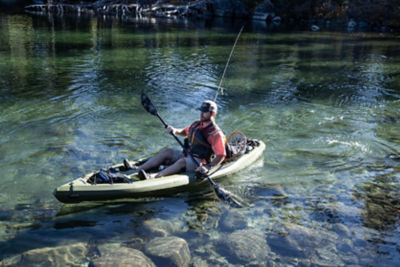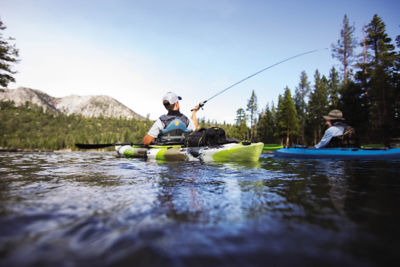How to Spool Your Baitcaster Reel
Avoid equipment worries on the water this fishing season and spool your baitcasting reel the right way with help from these spooling tips and tricks.
When the fish are biting and the action is non-stop, one of the worst things to occur for any fisherman is line trouble. Backlash, line twists and other fishing line dilemmas can put the brakes on any angler’s outing. Luckily, a number of these problems can be avoided or lessened by properly spooling your fishing reel in advance.
Spooling a baitcasting reel might seem intimidating at first, but by using these fishing Pro Tips you’ll see that the process is nothing to fear.
EQUIPMENT LIST
To effectively add new line to your baitcasting reel, you’ll need a few fishing supplies:
- Rod
- Reel
- Monofilament fishing line
- Pencil
- One fellow fisherman
- Braided fishing line (optional)
If you find yourself one fishing buddy shy of a full gear list, fear not. You can always employ a fishing line spooler to achieve a full baitcasting reel.
STEP-BY-STEP INSTRUCTION
With supplies in tow, you can now begin to spool your baitcasting reel. DICK’S Sporting Goods Associate Justin Lonchar states that the first step in this process should be to attach your reel to your fishing rod. “Next, you’ll want to feed the line through the first eyelet of the rod,” he says.
Once your fishing line is through the first eyelet, you can then attach it to your reel spool. Lonchar notes that you should feed the line through the worm guide at the front of the reel.
Next, you’ll want to wrap the line around the spool and tie an overhand knot around the main line. Finish by tying an overhand knot on the tag end and by pulling on the main line until both knots tighten down on the spool. This is also called an arbor knot.
After trimming the tag end, you can begin spooling your reel. This is where your friend will come in to help. Take your pencil through the hole of the packaged filler spool and have them hold your line vertically, like a tire on an axle. Place some tension on the line and begin to reel and fill up the spool. If you don’t have a friend available, use your fishing line spooler to house the filler spool as you reel.
To prevent line twists and future casting problems, you should want your fishing line to come off its filler spool the same way it goes onto your baitcaster reel. Since your reel spool feeds at the bottom of its turn, you want your filler spool to feed off the top. A good tip is to think of a cassette tape; as one reel loses tape, the other fills up.
Continue spooling your reel until it’s almost full of line.
“Ideally, you’ll want to leave one- eighth of an inch from the edge of the spool,” Lonchar says. “This will allow for smooth casting.”
Lastly, trim your spooled line from its package spool and thread through the remaining eyelets on your rod.
SPOOLING BRAIDED LINE
Braided fishing line is a popular option for fishermen due to its virtually stretch-free design and impressive strength-to-diameter ratio. Braided line is rather slick, however, which can lead to drag problems, backlash and line slippage on the spool. To combat this, it’s recommended that you use a monofilament backing prior to spooling your reel with braided line.
Begin your backing by feeding monofilament fishing line through the worm guide and tying it to the spool. Spool a couple of turns until you have a clean layer across your spool. The mono helps in creating friction on the braided line, allowing for better performance out of the reel.
To combine your braided and mono lines, “Grab your braid and connect to the monofilament by double-uni knot,” says Lonchar.
For more information on how to tie a double-uni knot, be sure to check out these fishing Pro Tips.
Once your lines are conjoined, begin spooling your braided line onto your reel as normal, leaving roughly one-eighth of an inch before the spool lip.
BONUS PRO TIP: For more information on braided line and other fishing line options, be sure to read up on the Three Best Fishing Lines for Bass Fishing.
With your baitcaster full of fresh fishing line and your setup ready to go, all that’s left is to choose your lure and head out to your favorite fishing spot. Use these angling Pro Tips to spool your reel the right way and leave your fishing line headaches at the dock.








